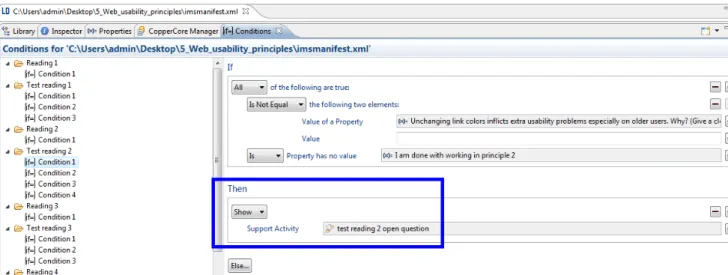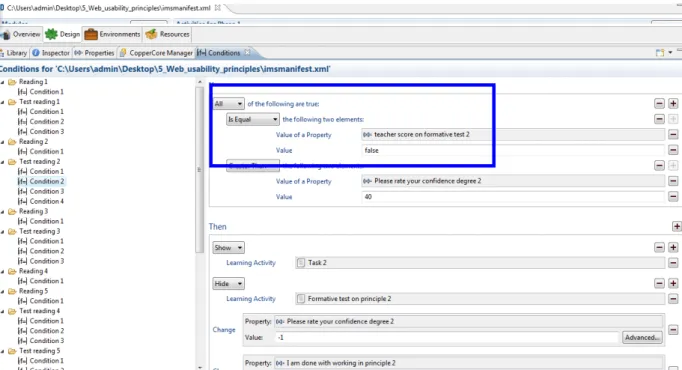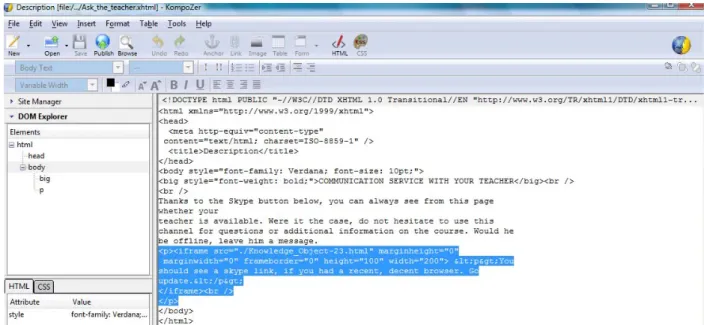Two student/teacher communication services in an adaptive IMS LD UoL
This document describes two instructor/student communication services integrated in an adaptive Unit of Learning (UoL) called "The Dangerous Knowledge Tour" (DKT) designed with the ReCourse IMS-LD authoring tool.
A communication service internal to the specification
The first communication service is subservient of adaptive assessment procedures which bundle cognitive and meta-cognitive aspects. It is qualified of "internal" because it is instantiated by using current features of the IMS-LD standard at its current stage of development.
Instructional rationale
The cognitive assessment bears on the answer given by a student the test (right/wrong). The metacognitive assessment concerns the confidence degree given by the student about the accurateness of his answer (0%, 20%, 40%, 60%, 80%, 100% of confidence). The value of these two parameters influences and regulates the sequencing of learning activities.
"Dangerous knowledge" is defined as incorrect knowledge (wrong answer) associated with a high degree of confidence (>40% confidence). In this specific case, students are quite
confident in the answer they gave, which is yet an erroneous information. When this double mistake (cognitive and metacognitive) is observed, the student is brought back to the content whose appropriation is insufficient. After a new study sequence, he is invited to pass the formative test again. Only when he gives the right answer with a higher confidence degree, is he allowed to move ahead in the UoL.
Formative tests
The UoL includes 5 formative tests. Each test bears on one specific piece of content. The test is displayed when the learner considers that he has acquired a sufficient level of mastery for this fragment of content. The tests comprise one question and one confidence evaluation1. The tests are either processed automatically or graded by the instructor. For the latest case, a communication service was developed.
Communication service
According to the IMS LD vocabulary, the grading of a test by an instructor implies the execution of a "Support activity", enacted as soon as the learner has completed the test.
1
Fig. 1. The communication service is located in the learning design
Fig. 2. The communication service is enacted via the properties/conditions facilities
Using "Properties" and "Conditions", it is possible to arrange the communication: - of the student's answer to the instructor;
- of the instructor's grade to the system so that it gets the necessary information (answer right or wrong) to present the next activity (either the next piece of content to study or, in case of dangerous knowledge, the previous piece of content),
Fig. 3. The communication service is needed in some tests to identify situations of dangerous knowledge and to adapt the sequencing of learning activities accordingly
A communication service external to the specification
The second communication service is put in the service of a help function through which the individual student can decide to ask questions or additional information about the course to the instructor.
Problem definition
Among the student-teacher interactions (Moore, 1989), help provision plays an important role. The availability of decent help facilities is acknowledged as a quality criteria by evaluation methodologies for eLearning courses (Hersda, 1992; Reeves, 1991; Meloche, 2000; Georges & Van De Poel, 2005).
Social presence theory (Lowenthal, 2009) emphasizes the value of presence in online
learning and classifies different communication media along a one-dimensional continuum of social presence, where the degree of social presence is equated to the degree of awareness of the other person, the “‘sense of being with another’” (Biocca, Harms, and Burgoon, 2003). Researchers have shown—in varying degrees—a relationship between social presence and student satisfaction and social presence and perceived learning (Richardson & Swan, 2003). Social presence theory question instructors' ability to project themselves as "real" or "there" in the instructional process.
Proposed solution
The solution suggested here couples the needs for help facility and for social presence. It boils them down these needs into an smart indicator, viz. a visual feature that help actors to
organise, orientate, and navigate through environments by providing contextual information that is relevant for performing learning tasks (Glahn & al. 2007). This indicator is borrowed to the Skype buttons, recently released by this third party. This button, located on a dedicated page, simultaneously provides a visual cue for teacher's presence and a direct communication service. This cue is explicitly related to help provision through an explanation given in the introductory section of the course.
Fig. 4. The communication service jointly address learner support and social presence needs
Technical aspects
The integration of this external communication service into the running IMS-LD Uol turned out to be seamless. It is achieved through a cut & paste of a ready-made piece of code.
Fig. 5. The code fragment (highlighted in blue) is easilty inserted into the page code via the editor
The teacher and the student must also tick the option "Allow my online status to be shown on the Web" in their account. Skype buttons work only in recent versions of Skype. Erratic problems with some browsers were observed.
Further research
- Does such communications service lead instructors to be overwhelmed by the quantity of student communications and by the rise in students' expectations for immediate responses?
- Has this mere indicator of teacher's presence some effect on the learning experience, no regard to its effective use?
- Is there any real added-value of the tight integration of the Skype button into the learning design or would a use of Skype (non-course bound) in parallel to the course have the same effect?
- does new indicators of social presence contribute to the blurring of boundaries between classroom and fully online courses as well as between student/instructor times for learning/teaching?
- In which circumstances is it appropriate to locate the help channel on a dedicated page or to locate it closer to contents or learning activities?
Difference between the two communication services
The implementation of the first communication service described here required nothing else than what is currently available in the IMS-LD standard. The second communication service was also incorporated in a learning design without changing anything in the IMS-LD
standard. The authoring tool smoothly supported the integration of an external Web 2.0 communication feature. Both communication services bear their own characteristics. They are not interchangeable. The internal communication service influences the adaptive process defined in the unit of learning, which is not the case with the Skype button. The use of the internal communication service is mandatory while using the external one is optional.
References
Richardson, J. C., & Swan, K. (2003). Examining social presence in online courses in relation to students' perceived learning and satisfaction. Journal of Asynchronous Learning Networks, 7(1), 68-88.
Georges, F., & Van De Poël, J.F. (septembre 2005). Evaluations d’un cours en ligne : produit, usage et impact. Paper presented at the 22nd conference of the AIPU, Genève.
Glahn, C., Specht, M., & Koper, R. (2007). Smart indicators on learning interactions. In E. Duval, R. Klamma & M. Wolpers (Eds.), EC-TEL 2007, 56-70. Berlin, Heidelberg: Springer.
HERDSA (1992). Challenging conceptions of teaching : Some prompts for good practice. Available on http://www.herdsa.org.au/CCT.php
Lowenthal, P. R. (2009). The evolution and influence of social presence theory on online learning. In T. T. Kidd (Ed.), Online education and adult learning: New frontiers for teaching practices (pp. 124-139). Hershey, PA: IGI Global.
Meloche, M. (2000). Évaluation des multimédias pédagogiques. (Evaluation of instructional multimedia).
Distances, vol. 4, n° 1, p. 7-45.
Moore, M.G. (1989) Three types of interaction, American Journal of Distance Education/3/2, 1-6.
Reeves, Thomas C. Ten Commandments for the Evaluation of Interactive Multimedia in Higher Education, Journal of Computing in Higher Education, v2, n2, p.84-113, Spr 1991.


